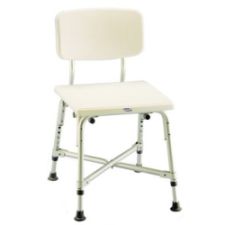Mobility shower chairs are used by people with limited ability to walk or stand for any length of time such as the disabled, the elderly, or anyone who is easily fatigued. Mobility shower seats enable a person unable to stand for long periods of time to sit in a tub or shower comfortably without fear of falling. Users can shower or bathe in privacy without the assistance of a caretaker.
Safety of Shower Chairs and Seats
The American Disabilities Act (ADA) has certain standards in the safety of shower seats. Regular shower chairs must be able to hold 250 pounds. Premier shower chair manufacturers have exceeded the weight to 555 pounds.

The chairs must also have rubberized legs to keep the chair from sliding in a slipper shower stall or bath tub. You may also choose a padded chair to make it more comfortable. Folding shower seats are available so that others can access the shower who don’t need the shower bench.
One of the most important benefits of the shower seat in a mobility bathroom setting use, is it gives the user, the opportunity for independence. As long as the user can sit on the shower chair without assistance he/she can complete their bath or shower in privacy and may only need assistance to get in and out of the shower/tub.
Shower Chairs Help Caretakers
A mobility shower chair also allows the caretaker to rest or complete tasks nearby. Of course the caretaker should remain in hearing distance but this frees the caretaker from a duty the user can do for himself/herself.
Costs of Mobility Shower Chairs
The price range of a mobility shower chair is about $50 for a folding, white plastic chair to nearly $300 for a chair that swivels and glides on its own runners. Buying a shower chair online is a simple process and online shower chair reviews aid in the purchase.
Maintenance of mobility shower seats can range from tightening screws in the simpler plastic benches to needing to take a more elaborate shower seat to an expert for repairs. The more parts the shower seat contains the more often you’ll need repairs.
A mobility shower chair can make your care-taking duties easier to give your patient a shower or bath. It can also make your patient self-sufficient with minimum assistance.




 Mobility bathrooms come in many different forms and offer no slip flooring, lower entry points, hand rails, easy access doors, ramps, built in seats, and more. You can go as far as you want in customizing your bathroom. With each addition, the benefits and costs are pleasantly surprising.
Mobility bathrooms come in many different forms and offer no slip flooring, lower entry points, hand rails, easy access doors, ramps, built in seats, and more. You can go as far as you want in customizing your bathroom. With each addition, the benefits and costs are pleasantly surprising.